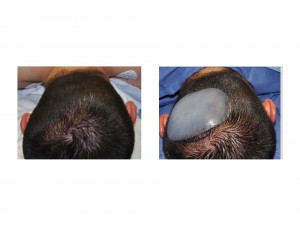Background: Occipital plagiocephaly is a well recognized skull shape deformity that is caused by deformational forces. Whether this is the result of intrauterine constraint, post delivery head positioning or both, the thin and malleable skull bones are prone to be inadvertently molded into a deformed shape. This classically appears as a flatness on one side of the back of the head with some protrusion of the opposite side and a well described entire craniofacial scoliosis of varying degrees.
While cranial molding helmets can be very effective at the treatment of deformational occipital plagiocephaly, their effectiveness diminishes after 12 to 18 months of age. Once this non-surgical treatment window has passed, surgery is the only effective treatment. But the concept of surgically taking off the entire back of the head and reconstructing it can be too invasive for many patients and is only appropriate in the most severe occipital flattening cases. As an adult, however, bony reconstruction is not an option given the thickness of the skull bones and the sheer magnitude and risks of major skull reshaping surgery.
Flatness of the back of the head in adults is an often unrecognized aesthetic concern. But to the patient so affected it is well recognized with many maneuvers done to camouflage it from hair styles to hats. Correction of a unilateral occipital plagiocephaly in adults is most effectively and simply done using an implant that is placed on the bone. This type of occipital implant can be done using either custom or semi-custom designs. The surgery to place them remains the same regardless of how the implant is made.
Case Study: This 25 year-old male wanted to improve the shape of the back of his head. He had a significant of the right side of the back of his head which was the direct result of how he slept as an infant. He had all of the typical associated findings with it including a more forward positioning of the right ear (ear asymmetry), some mild left occopital protrusion and other more skull shape changes. He was offered the choice of having a 3D CT scan done and a custom implant made for it or to use an existing right occipital implant (from a custom implant made from another patient) instead. (what I call ‘semi-custom’ implant) Due to economic considerations, he chose a semi-custom occipital implant design.


A semi-custom occipital implant offers a cost-effective approach to treatment of occipital asymmetry due to congenital plagiocephaly. It is successful because the shape of the skull deformity is fairly predictable and the thickness of the scalp provides some forgiveness for edge-transitions.
Highlights:
- Unilateral occipital plagiocephaly can be effectively treated as an adult by the placement of an implant for skull reshaping/augmentation.
- Unilateral occipital implants can be custom made or a semi-custom type implant can be used.
- An occipital implant for a flatness on one side of the back of the head is placed through a low occipital hairline incision.
Dr. Barry Eppley
Indianapolis, Indiana



